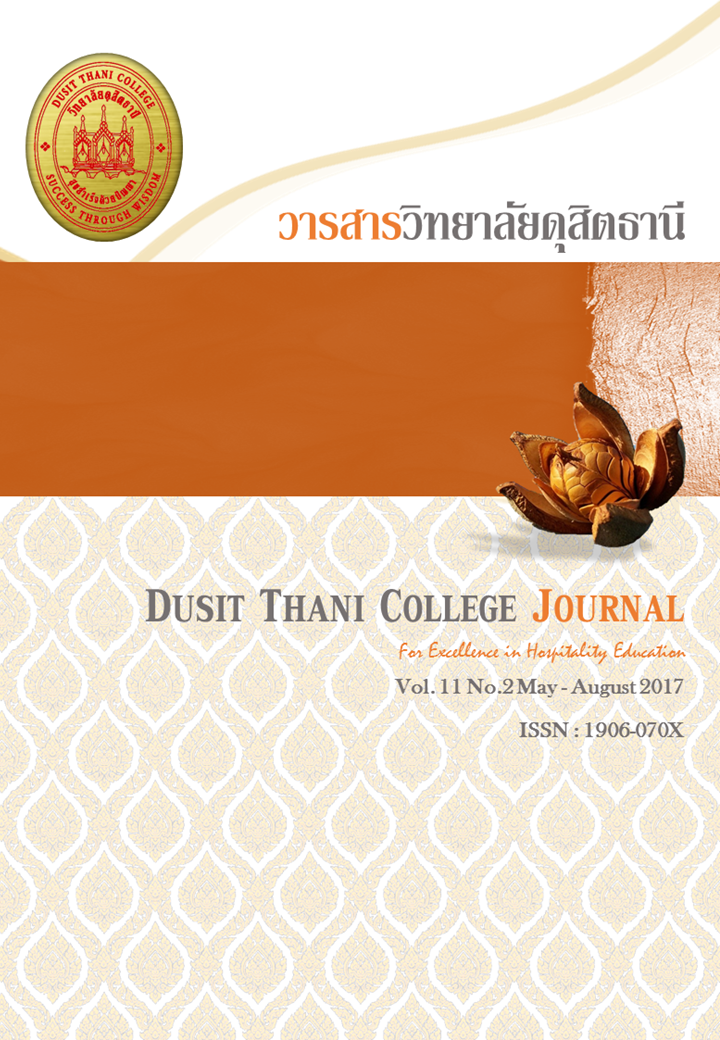ปัจจัยเชิงสาเหตุที่มีผลกระทบต่อความสามารถในการจัดการความเสี่ยงของสถาบันอุดมศึกษาในประเทศไทย
Main Article Content
บทคัดย่อ
ภายใต้กระแสโลกาภิวัตน์ มีการเปลี่ยนแปลงอย่างรวดเร็วทั้งสภาพแวดล้อม สังคม เศรษฐกิจ รวมทั้งการแข่งขันที่มีแนวโน้มรุนแรงมากขึ้น ส่งผลให้องค์การต้องเผชิญกับความไม่แน่นอน รูปแบบความเสี่ยงมีความซับซ้อน และระดับผลกระทบมีความรุนแรงมากขึ้น ผู้บริหารจึงต้องให้ความสำคัญในการกำหนดให้มีระบบการจัดการความเสี่ยงที่เหมาะสม และมีประสิทธิภาพ ดังนั้น การจัดการความเสี่ยงจึงถือเป็นเครื่องมือทางด้านการบริหารที่สำคัญขององค์การในยุคปัจจุบัน บทความนี้จึงต้องการที่จะนำเสนอแนวคิดเกี่ยวกับปัจจัยเชิงสาเหตุที่ส่งผลกระทบต่อความสามารถในการจัดการความเสี่ยง ได้แก่ ภาวะผู้นำแห่งการเปลี่ยนแปลง ประสบการณ์การเรียนรู้ขององค์การ การสนับสนุนด้านทรัพยากร และผลกระทบความสามารถในการจัดการความเสี่ยงที่มีต่อความสำเร็จขององค์การ เพื่อเป็นประโยชน์สำหรับการนำไปประยุกต์ใช้ในการดำเนินงานด้านการจัดการความเสี่ยงขององค์การ และเพื่อศึกษาเชิงประจักษ์ในอนาคต
Article Details
นโยบายการพิจารณากลั่นกรองบทความ
- บทความวิจัยและบทความวิชาการทุกเรื่องที่จะได้รับการตีพิมพ์ต้องผ่านการพิจารณากลั่นกรองโดยผู้ทรงคุณวุฒิ (Peer Review) ในสาขาที่เกี่ยวข้อง จำนวน 3 ท่าน/บทความ
- บทความ ข้อความ ภาพประกอบและตารางประกอบที่ลงตีพิมพ์ในวารสารเป็นความคิดเห็นส่วนตัวของผู้เขียน กองบรรณาธิการไม่จำเป็นต้องเห็นด้วยเสมอไป และไม่มีส่วนรับผิดชอบใด ๆ ถือเป็นความรับผิดชอบของผู้เขียนแต่เพียงผู้เดียว
- บทความที่จะได้รับการตีพิมพ์จะต้องไม่เคยตีพิมพ์ เผยแพร่ที่ใดมาก่อน และไม่อยู่ระหว่างการพิจารณาของวารสารฉบับอื่น หากตรวจสอบพบว่ามีการตีพิมพ์ซ้ำซ้อน ถือเป็นความรับผิดชอบของผู้เขียนแต่เพียงผู้เดียว
- บทความใดที่ผู้อ่านเห็นว่าได้มีการลอกเลียนหรือแอบอ้างโดยปราศจากการอ้างอิง หรือทำให้เข้าใจผิดว่าเป็นผลงานของผู้เขียน กรุณาแจ้งให้กองบรรณาธิการวารสารทราบจะเป็นพระคุณยิ่ง
เอกสารอ้างอิง
management practices in construction organizations. Procedia-Social and Behavioral Sciences 194 (2015) 201-210.
American Marketing Association. (2005). AMA marketing encyclopedia: issues and trends shaping the future. Chicago : American Marketing Association.
Aragon-Correa, A. and Sharma, S. (2003). A contingent resources-based view of proactive corporate environment strategy. Academy of Management Review, 28(1), P.71-88.
Aragon-Correa, A. and Sharma, S. (2003). A contingent resources-based view of proactive corporate environment strategy. Academy of Management Review, Vol.28 No.1, P.71-88.
Bass, B. M. & Avolio, B. J. (1994). Improving Organizational Effectiveness through Transformational Leadership. Thousand Oaks: SAGE Publication.
Barney, J (1991). Firm resource and sustained competitive advantage. Journal of Management, Volume 17, Issue (1), Page 99-120.
Beatriz Fernández-Muñiz, José Manuel Montes-Peón, Camilo José Vázquez-Ordás (2014) Safety leadership, risk management and safety performance in Spanish firms. Safety Science, Volume 70, December 2014, Pages 295-307.
Chaiwong, Varachok. (2006). Research and Development Professionals. Bangkok : n.p.
Coelho, F.J., Easingwood, C., (2003). Multiple Channels in Services: Pro, Cons and Issues.
The Service Industries 24, 1.-29.
COSO. (2004). The Committee of Sponsoring Organization of Treadway Commission. Enterprise Management – Integrated Framework. ERM Executive Summary, (Online) : www.coso.org.com, December 13, 2015.
Daft, R.L.(2001). Organization theory and design (7th ed.). Maronville, Mo : Souts-Western College.
Federation of Thai industries. (2009). Logistics performance assessment tool of SMEs.
SMEs Projects.
Girotra, K., Netessine, S. (2014). The Risk-Driven Business Model : Four Questions that Will
Define Your Company. Boston : Harvard Business Review Press.
Grant, Robert M. (1991). The resource- based theory of competitive advantage: implications for strategy formulation.” Knowledge and Strategy 33, 3: 3-23.
Hicks-Clarke, D.Iles, P. (2000), “Climate for diversity and its effects on career and organizational attitudes and perceptions,” Personnel Review, 29/3: 324-345.
Kanjanavasee, Sirichai. (2007). Evaluation theory. Bangkok : Chulalongkorn University Press.
Kolb, David A., Irwin M. Rubin and Joyce M. Osland. (1991). Organization Behavior: An Experiential Approach. New Jersey: Prentice-Hall.
Makasiranon, Veerawut. (2002). Modern Management Series. Bangkok : Expernet Co.,Ltd.
Marquardt, M.J. (1996). Building the Learning Organization : A Systems Approach to Quantum Improvement and Global Success. New York : McGraw-Hill.
Mintzberg, Henry. (1971). The Structuring of Organizations. New Jersey: Prentice-Hall Inc,
Office of Education Standard and Quality Assurance. (2014). Quality Assurance. Phetchaburi Rajabhat University.
Phuekpitikun, Sittisak. (2003). Balanced Scorecard. Bangkok : Duang Kamol Samai.
Pollard et al. (2005). Risk management capabilities- Towards “Mindfulness” for the international water utility sector. Proceeding of the Walter Contamination Emergencies: Enhansing Our Response conference.
Rodrigues, A.G. (2001). Managing and Modeling Project Risk Dynamics : System Dynamics-Based Framework. in The Fourth European Project Management Conference. p. 58.
Saardchom, Narumon. (2007). Risk Management. Bangkok : K.ponpim Press.
Sakhagron, Jantana., Henchokchaichana, Niphan., and Srijanphet, Silapapron, (2007).
Internal control and Internal Audit. Bangkok : TPN Press.
Sharma, D., Sahay, B. S., and Sachan, A., (2004). Modelling distributor performance index using system dynamics approach, Asia Pacific Journal of Marketing and Logistics, 16(3), 37-67.
Tochinda, Banyong., and Punyasith, Amnard. (2013). Risk management : the methods of
risk mitigation and how to get rid of risks in your organization. Bangkok : ruamsarn
(1997) Co.,Ltd.
Waldman, D. A., Siegel, S. D. and Javidan, M. (2006). Components of CEO Transformational Leadership and Corporate Social Responsibility. Journal of Management Studies. 43(8), 1703-1725.
Weiner, B. J. (2009). A Theory of Organizational Readiness for Change. Retrieved February 17th, 2016, from https://www.implementationscience.com/content/4/1/67.
Wiphatkrut, Sunthree., Hongkrailers, Pricha., and Panyasiri, Chaiyanant. (2015). Critical
success factors affecting the risk management of Rajabhat Universities in Thailand.
Rajabhat Maha Sarakham journal, 9(2), 167-168.
Worley, C. and E. Lawler. (2006). Designing organizations that are built to change. Sloan Management Reivew 48(1): 19-23.
Wernerfelt, B. (1984). A resource-based view of the firm. Strategic Management Journal, 5,171-180.
Yang, L., Huang, C. & Wu, K. (2011). The association among project managers leadership style, teamwork and project success. International Journal of Project Management, 29(3), 258-267.


